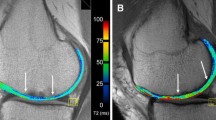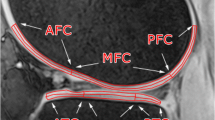Abstract
Objective
The aim of this study was to evaluate the correlations between T2 value, T2* value, and histological grades of degenerated human articular cartilage.
Materials and methods
T2 mapping and T2* mapping of nine tibial osteochondral specimens were obtained using a 3-T MRI after total knee arthroplasty. A total of 94 ROIs were analyzed. Histological grades were assessed using the David–Vaudey scale. Spearman’s rho correlation analysis and Pearson’s correlation analysis were performed.
Results
The mean relaxation values in T2 map with different histological grades (0, 1, 2) of the cartilage were 51.9 ± 9.2 ms, 55.8 ± 12.8 ms, and 59.6 ± 10.2 ms, respectively. The mean relaxation values in T2* map with different histological grades (0, 1, 2) of the cartilage were 20.3 ± 10.3 ms, 21.1 ± 12.4 ms, and 15.4 ± 8.5 ms, respectively. Spearman’s rho correlation analysis confirmed a positive correlation between T2 value and histological grade (ρ = 0.313, p < 0.05). Pearson’s correlation analysis revealed a significant negative correlation between T2 and T2* (r = −0.322, p < 0.05). Although T2* values showed a decreasing trend with an increase in cartilage degeneration, this correlation was not statistically significant in this study (ρ = −0.192, p = 0.129).
Conclusions
T2 mapping was correlated with histological degeneration, and it may be a good biomarker for osteoarthritis in human articular cartilage. However, the strength of the correlation was weak (ρ = 0.313). Although T2* values showed a decreasing trend with an increase in cartilage degeneration, the correlation was not statistically significant. Therefore, T2 mapping may be more appropriate for the initial diagnosis of articular cartilage degeneration in the knee joint. Further studies on T2* mapping are needed to confirm its reliability and mechanism in cartilage degeneration.





Similar content being viewed by others
References
Li X, Cheng J, Lin K, Saadat E, Bolbos RI, Jobke B, et al. Quantitative MRI using T1rho and T2 in human osteoarthritic cartilage specimens: correlation with biochemical measurements and histology. Magn Reson Imaging. 2011;29(3):324–34.
Choi JA, Gold GE. MR imaging of articular cartilage physiology. Magn Reson Imaging Clin N Am. 2011;19(2):249–82.
Bae WC, Chen PC, Chung CB, Masuda K, D'Lima D, Du J. Quantitative ultrashort echo time (UTE) MRI of human cortical bone: correlation with porosity and biomechanical properties. J Bone Miner Res Off J Am Soc Bone Miner Res. 2012;27(4):848–57.
David-Vaudey E, Ghosh S, Ries M, Majumdar S. T2 relaxation time measurements in osteoarthritis. Magn Reson Imaging. 2004;22(5):673–82.
Dunn TC, Lu Y, Jin H, Ries MD, Majumdar S. T2 relaxation time of cartilage at MR imaging: comparison with severity of knee osteoarthritis. Radiology. 2004;232(2):592–8.
Stahl R, Blumenkrantz G, Carballido-Gamio J, Zhao S, Munoz T, Hellio Le Graverand-Gastineau MP, et al. MRI-derived T2 relaxation times and cartilage morphometry of the tibio-femoral joint in subjects with and without osteoarthritis during a 1-year follow-up. Osteoarthr Cartil OARS Osteoarthr Res Soc. 2007;15(11):1225–34.
Bittersohl B, Hosalkar HS, Hughes T, Kim YJ, Werlen S, Siebenrock KA, et al. Feasibility of T2* mapping for the evaluation of hip joint cartilage at 1.5T using a three-dimensional (3D), gradient-echo (GRE) sequence: a prospective study. Magn Reson Med Off J Soc Magn Reson Med Soc Magn Reson Med. 2009;62(4):896–901.
Mamisch TC, Hughes T, Mosher TJ, Mueller C, Trattnig S, Boesch C, et al. T2 star relaxation times for assessment of articular cartilage at 3 T: a feasibility study. Skelet Radiol. 2012;41(3):287–92.
Newbould RD, Miller SR, Toms LD, Swann P, Tielbeek JA, Gold GE, et al. T2* measurement of the knee articular cartilage in osteoarthritis at 3T. J Magn Reson Imaging JMRI. 2012;35(6):1422–9.
Takayama Y, Hatakenaka M, Tsushima H, Okazaki K, Yoshiura T, Yonezawa M, et al. T1rho is superior to T2 mapping for the evaluation of articular cartilage denaturalization with osteoarthritis: radiological-pathological correlation after total knee arthroplasty. Eur J Radiol. 2013;82(4):e192–8.
Friedrich KM, Shepard T, de Oliveira VS, Wang L, Babb JS, Schweitzer M, et al. T2 measurements of cartilage in osteoarthritis patients with meniscal tears. AJR Am J Roentgenol. 2009;193(5):W411–5.
Apprich S, Mamisch TC, Welsch GH, Stelzeneder D, Albers C, Totzke U, et al. Quantitative T2 mapping of the patella at 3.0T is sensitive to early cartilage degeneration, but also to loading of the knee. Eur J Radiol. 2012;81(4):e438–43.
Kwack K-S, Min B-H, Cho JH, Kim JM, Yoon S-H, Kim SY. T2 relaxation time mapping of proximal tibiofibular cartilage by 3-Tesla magnetic resonance imaging. Acta Radiol. 2009:1–8.
Miese FR, Zilkens C, Holstein A, Bittersohl B, Kropil P, Mamisch TC, et al. Assessment of early cartilage degeneration after slipped capital femoral epiphysis using T2 and T2* mapping. Acta Radiol. 2011;52(1):106–10.
Bittersohl B, Miese FR, Hosalkar HS, Herten M, Antoch G, Krauspe R, et al. T2* mapping of hip joint cartilage in various histological grades of degeneration. Osteoarthr Cartil OARS Osteoarthr Res Soc. 2012;20(7):653–60.
Bittersohl B, Miese FR, Hosalkar HS, Mamisch TC, Antoch G, Krauspe R, et al. T2* mapping of acetabular and femoral hip joint cartilage at 3 T: a prospective controlled study. Investig Radiol. 2012;47(7):392–7.
Welsch GH, Mamisch TC, Hughes T, Zilkens C, Quirbach S, Scheffler K, et al. In vivo biochemical 7.0 Tesla magnetic resonance: preliminary results of dGEMRIC, zonal T2, and T2* mapping of articular cartilage. Investig Radiol. 2008;43(9):619–26.
Welsch GH, Trattnig S, Hughes T, Quirbach S, Olk A, Blanke M, et al. T2 and T2* mapping in patients after matrix-associated autologous chondrocyte transplantation: initial results on clinical use with 3.0-Tesla MRI. Eur Radiol. 2010;20(6):1515–23.
Aisen AM, McCune WJ, MacGuire A, Carson PL, Silver TM, Jafri SZ, et al. Sonographic evaluation of the cartilage of the knee. Radiology. 1984;153(3):781–4.
Castriota-Scanderbeg A, De Micheli V, Scarale MG, Bonetti MG, Cammisa M. Precision of sonographic measurement of articular cartilage: inter- and intraobserver analysis. Skelet Radiol. 1996;25(6):545–9.
Disler DG, Raymond E, May DA, Wayne JS, McCauley TR. Articular cartilage defects: in vitro evaluation of accuracy and interobserver reliability for detection and grading with US. Radiology. 2000;215(3):846–51.
Pai A, Li X, Majumdar S. A comparative study at 3 T of sequence dependence of T2 quantitation in the knee. Magn Reson Imaging. 2008;26(9):1215–20.
Dardzinski BJ, Laor T, Schmithorst VJ, Klosterman L, Graham TB. Mapping T2 relaxation time in the pediatric knee: feasibility with a clinical 1.5-T MR imaging system. Radiology. 2002;225(1):233–9.
Pauli C, Bae WC, Lee M, Lotz M, Bydder GM, D'Lima DL, et al. Ultrashort-echo time MR imaging of the patella with bicomponent analysis: correlation with histopathologic and polarized light microscopic findings. Radiology. 2012;264(2):484–93.
Williams A, Qian Y, Bear D, Chu CR. Assessing degeneration of human articular cartilage with ultra-short echo time (UTE) T2* mapping. Osteoarthr Cartil OARS Osteoarthr Res Soc. 2010;18(4):539–46.
Kijowski R, Blankenbaker DG, Munoz Del Rio A, Baer GS, Graf BK. Evaluation of the articular cartilage of the knee joint: value of adding a T2 mapping sequence to a routine MR imaging protocol. Radiology. 2013;267(2):503–13.
Domayer SE, Kutscha-Lissberg F, Welsch G, Dorotka R, Nehrer S, Gabler C, et al. T2 mapping in the knee after microfracture at 3.0 T: correlation of global T2 values and clinical outcome—preliminary results. Osteoarthritis and cartilage/OARS, Osteoarthritis Research. Society. 2008;16(8):903–8.
Quirbach S, Trattnig S, Marlovits S, Zimmermann V, Domayer S, Dorotka R, et al. Initial results of in vivo high-resolution morphological and biochemical cartilage imaging of patients after matrix-associated autologous chondrocyte transplantation (MACT) of the ankle. Skelet Radiol. 2009;38(8):751–60.
Quaia E, Toffanin R, Guglielmi G, Ukmar M, Rossi A, Martinelli B, et al. Fast T2 mapping of the patellar articular cartilage with gradient and spin-echo magnetic resonance imaging at 1.5 T: validation and initial clinical experience in patients with osteoarthritis. Skelet Radiol. 2008;37(6):511–7.
Paul PK, Jasani MK, Sebok D, Rakhit A, Dunton AW, Douglas FL. Variation in MR signal intensity across normal human knee cartilage. J Magn Reson Imaging JMRI. 1993;3(4):569–74.
Acknowledgments
Professor Lee KB, Dr. Jin Long Hao and Xuenan Cui are gratefully acknowledged. This study was supported by a grant from the Korea Healthcare Technology R&D Project, Ministry for Health, Welfare, and Family Affairs, Republic of Korea (A091120).
Conflict of interest
There are no conflicts of interest to declare.
Author information
Authors and Affiliations
Corresponding author
Rights and permissions
About this article
Cite this article
Kim, T., Min, BH., Yoon, SH. et al. An in vitro comparative study of T2 and T2* mappings of human articular cartilage at 3-Tesla MRI using histology as the standard of reference. Skeletal Radiol 43, 947–954 (2014). https://doi.org/10.1007/s00256-014-1872-z
Received:
Revised:
Accepted:
Published:
Issue Date:
DOI: https://doi.org/10.1007/s00256-014-1872-z




